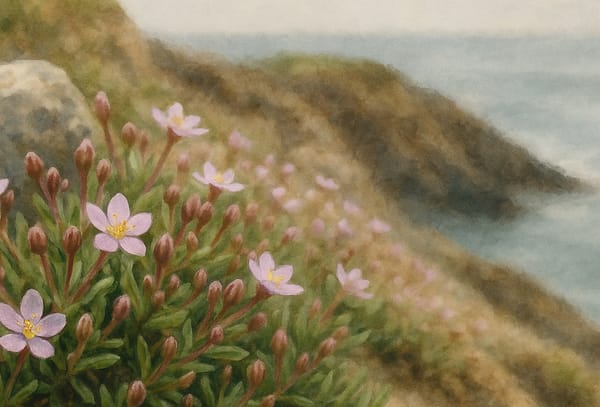Tucked into the rocky margins of Cornwall’s windswept coastline, Rock Sea Spurrey flourishes where few other plants dare. With starry pink blossoms and fleshy, salt-tolerant leaves, this hardy native wildflower is more than just a splash of beauty—it’s a living symbol of the resilience, heritage, and ecological balance of the Cornish shore.
A Native of the Edge
Found clinging to cliffs, scree, and stone walls across Cornwall and the wider UK, Rock Sea Spurrey has long captured the imagination. Its presence in exposed, saline environments has made it a metaphor for perseverance in regional poetry and literature—a small but determined force holding fast in wild places.
In folklore and cultural memory, it’s sometimes associated with seabirds, puffins, and other creatures of the shoreline. Its ability to thrive in soils enriched by sea spray and bird droppings speaks to its close relationship with these habitats. While perhaps lesser known than daisies or thrift, it holds a quiet place in Cornwall’s coastal plant lore.
Traditional Uses
In folk medicine, Rock Sea Spurrey was once valued for its antiseptic and anti-inflammatory properties. Remedies brewed from its leaves were used to treat coughs, bronchitis, and digestive issues. There are also accounts of its young shoots and leaves being added to soups and salads—offering a slightly salty, bitter flavour that echoed the sea itself.
While such culinary use is uncommon today, its historical role in both healing and nutrition reflects how coastal communities turned to native plants for sustenance and support.
Ecological Significance
Beyond its cultural value, Rock Sea Spurrey plays a vital ecological role in Cornwall’s coastal landscapes. Its deep, spreading roots help stabilise fragile cliffs, bind loose soil, and protect slopes from erosion—especially important along Cornwall’s rugged and dynamic shoreline.
It also acts as a pioneer species, colonising harsh, salty ground where few other plants can survive. In doing so, it creates the conditions for other native wildflowers to follow, enriching biodiversity and helping restore degraded habitats.
Its pink flowers offer nectar to pollinators like bees and butterflies, while the dense foliage provides cover for insects and food for birds. It may be small, but its contribution to the wider web of coastal life is significant.
Growing Rock Sea Spurrey in Coastal Gardens
Hardy, undemanding, and visually striking in its own subtle way, Rock Sea Spurrey is a smart addition to coastal gardens—especially those aiming to reflect or support local ecology.
Care and Growing Tips
| Factor | Advice |
|---|
| Sunlight | Full sun preferred |
| Soil | Sandy or rocky; poor, well-drained, saline-tolerant |
| Watering | Minimal once established; avoid overwatering |
| Exposure | Thrives in windy, exposed, and salt-spray conditions |
| Maintenance | Low; occasional tidy-up of dead growth if desired |
| Wildlife Value | Supports pollinators; good for coastal biodiversity |
Where to plant: It’s ideal for rock gardens, green roofs, dry borders, and the edges of paths or stone walls—particularly in exposed or sea-facing areas.
Propagation: Sow seeds in spring or autumn, pressing lightly into the soil. It can also be propagated by cuttings and tends to establish quickly in suitable conditions.
Conservation note: If harvesting for culinary or cosmetic purposes, do so responsibly and avoid wild collection unless you are certain the population is sustainable.
The Wild Heart of Cornwall’s Coast
More than just a wildflower, Rock Sea Spurrey is a living link between Cornwall’s ancient coastline and its present-day ecology. It reminds us that beauty can thrive in adversity—and that even the smallest plants play a part in holding the land together. In gardens and wild cliffs alike, it continues to stand as a quiet guardian of the Cornish shore.











